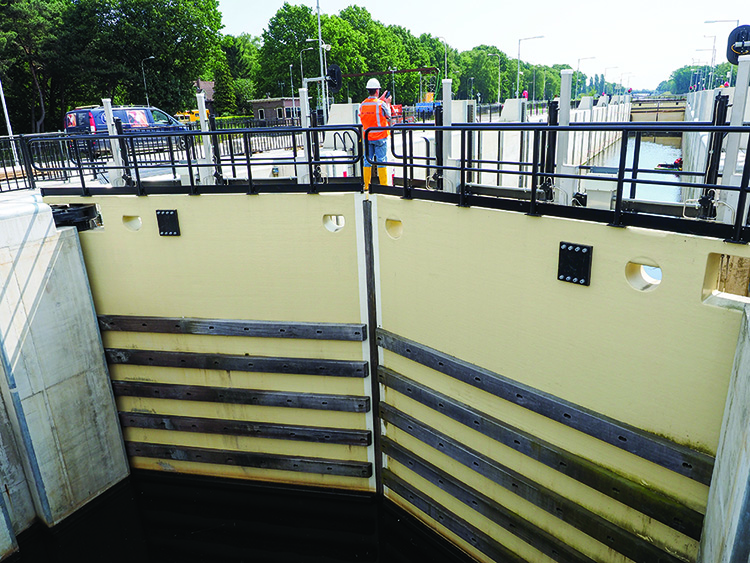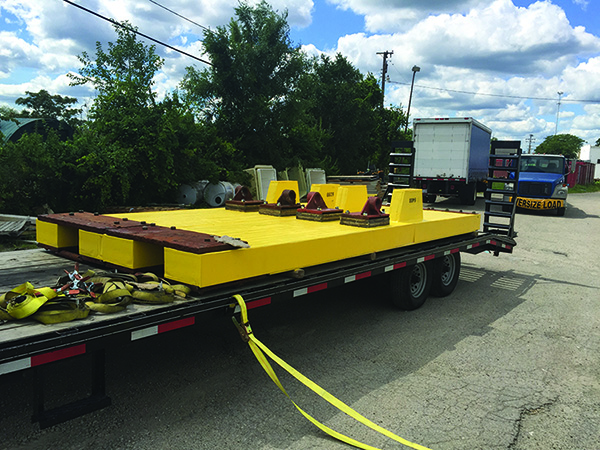

Design Considerations for Composite Hydraulic Structures
Over the past 15 to 20 years, hydraulic structures using FRP composites have been designed, manufactured and installed in several countries, including the United States, the Netherlands, Spain, China, the United Kingdom and France. Many of the original waterway navigational structures around the world have far exceeded their original design life – some to the point of failure. Corrosion-resistant, low-maintenance composite hydraulic structures are poised to take their place in locks, dams, levees, pump stations and other systems that involve valves, gates, walls, piling, mooring facilities and more.
As in any composite application, careful examination of design considerations for hydraulic structures are paramount. Because the market encompasses a bevy of structures and accompanying components, it’s impossible to cover specific design principles within this column. For instance, the design process for a vertical lift gate varies from that of a stoplog on a dam. However, there are several overarching considerations, five of which are presented here: design requirements, material selection, structural concepts, deflection requirements and cost.
Before examining those considerations, it’s important to note work that has already been done to create best practices and design standards for hydraulic structures. In 2018, the U.S. Army Corps of Engineers led publication of a guide specification entitled “UFGS 35 20 15 FRP Composites for Low-Head Water Control Structures” that covers stoplogs, vertical lift gates, weir dams and more.
Another effort is currently underway by PIANC, the World Association for Waterborne Transport Infrastructure. In order to identify “best practices” of composites in the hydraulic structures market and develop applicable guidance documents, PIANC established an international working group – WG-191, Composites for Hydraulic Structures – in 2016. The WG-191 has developed a draft report entitled “Composites for Hydraulic Structures,” which was submitted to PIANC’s Inland Navigation Commission in February for review, editing and publication.
The report summarizes state-of-the-art FRP composites for hydraulic structures, including material characterization, engineering (science) evaluations, design, construction, repair and cost analyses. Emphasis is placed on successful applications of composites in waterfront, marine and navigational structures, such as lock doors, gates, in-situ and under water repair, and flood protection systems.
In particular, the report highlights several applications of FRP composites for hydraulic structural systems that enhance durability, reduce downtime to replace or rehabilitate traditional structures, reduce embodied energy and exhibit other advantages. (Two of the applications are depicted in this column.) Ideally, the contents of this report will help designers and promoters of hydraulic structures by providing guidance to develop and operate safe, economical, durable structural systems for waterways utilizing FRP composites.
In the meantime, here is an overview of the general design considerations for composite hydraulic structures:
Identify Design Requirements
The requirements of a new FRP structure are usually based on the requirements of the existing structure made of conventional materials, including the geometric boundary conditions and various loads on the structure. Geometric boundary conditions focus on the dimension of the structure, fatigue cycles, sustained stresses and environmental conditions, such as the range of operating temperature. The loads considered may include complex wave loads, dead load, torsion and longitudinal loads, ice loads, wind loads, water flows and potential barge collisions.
Consider Material Selection
The properties of composite materials and their manufacturing process usually drive the selection of FRP composite materials. The lamina properties of FRPs, including the properties of core materials (if involved), are calculated, and the material safety factors and design values are determined. Manufacturing methods suitable for the proposed structure should be selected to achieve high fiber content and to enhance the strength and stiffness of the material. Designers also can take advantage of the fact that composite materials are anisotropic, so they can be designed and manufactured with properties varying in different directions to suit the application needs, dependent on load paths.
During the material selection process, designers should consider numerous factors, including corrosion, weathering and the material safety factor. With regard to safety factor, uncertainties due to a combination of effects corresponding to various knock-downs (under temperature, moisture, sustained stress/creep and fatigue) should be taken into account. In addition, uncertainties regarding targeted material design properties should be considered. It is extremely important to note that proper selection of the manufacturing process, as well as the constituent materials (resins, fibers, additives) for a tailor-made composite structure, are essential to meet minimum design and performance requirements.
Define the Structural Concepts
The next step is to define the structural concepts of the proposed FRP structure. Usually, a minimum of three important aspects should be considered: 1) use of a limited number of connections, 2) optimal design under water or barge impact loads and leakage flows and 3) uniform load transfer over the entire structure. The design includes guiding principles for the structural concepts, description and calculation of different options, such as sandwich structure versus box beam. Then, the most suitable option of optimal design is selected to meet the strength and deflection requirements.
Take Deflection Requirements into Account
In some cases, the maximum deflection requirement influences the design of a composite hydraulic structure since the stiffness of the GFRP composite is low. To meet the stiffness requirement, CFRP can be used at a different cost scenario, recognizing that the potential for galvanic corrosion exists when in direct contact with steel.

Perform a Cost Comparison
The cost comparison should be made among different design options. A life cycle cost analysis should be used when designing with composites as an alternative to conventional materials because FRP offers longer service life and lower maintenance costs, but at a higher initial cost in some scenarios and at a competitive price in other cases, such as wicket gates.
These five considerations only begin to address the budding hydraulic structures market. Educating owners and designers about composites – including specification developments and training fabricators of composite systems – are real challenges facing the market. Even so, the future is promising, provided that high-quality workmanship and installation procedures are ensured. Based on limited in-service data, it is safe to conclude that GFRP systems for hydraulic structures are resulting in longer service life, lower initial costs (in some cases) and reduced life-cycle costs with enhanced structural performance.

SUBSCRIBE TO CM MAGAZINE
Composites Manufacturing Magazine is the official publication of the American Composites Manufacturers Association. Subscribe to get a free annual subscription to Composites Manufacturing Magazine and receive composites industry insights you can’t get anywhere else.




